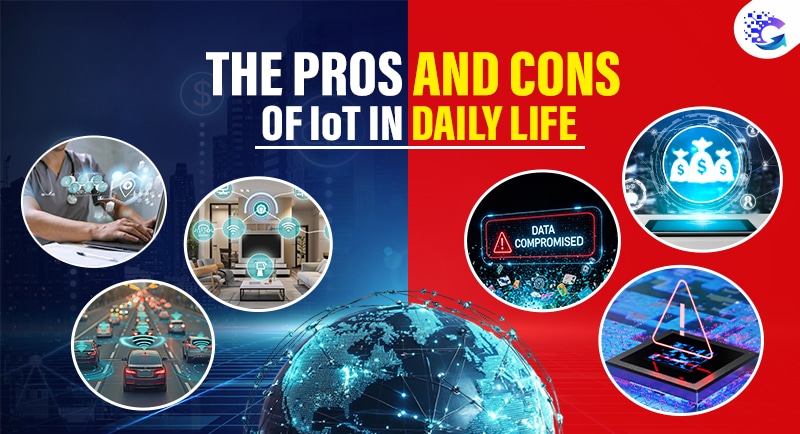How do you feel when your refrigerator indicates you are running out of vegetables? Or your smartwatch provides your heartbeat in real time. How many times do you adjust the temperature of your AC before reaching home, or turn off your home lights from your phone while travelling? These are all possible due to the Internet of Things (IoT).
IoT has penetrated its roots into our lives; to utilize its potential, you should consult with a reputed IoT company in India. However, the real question lies in whether it is making life more convenient and connected. Is it a blessing from recent IT innovations? These devices bring plenty of challenges along with the benefits.
Let’s dive deeper and try to understand the challenges and benefits these devices bring to our lives.
What is IoT in Simple Terms?
The Internet of Things (IoT) refers to a network of devices, beyond just computers and smartphones, that connect to the internet and share data. From smart thermostats and wearable health trackers to connected cars and voice assistants, IoT allows everyday objects to “talk” to each other and to us.
At its core, IoT is about making devices smarter, more responsive, and capable of acting without constant human input. And while this sounds futuristic, it’s already deeply woven into our daily routines.
The Pros of IoT in Daily Life
1. Convenience at Your Fingertips
Imagine waking up and having your coffee machine start brewing the moment your alarm rings. IoT makes this seamless automation possible. Devices can be controlled remotely, saving you time and effort. From adjusting room temperatures while away to preheating ovens before you arrive home, IoT simplifies everyday tasks.
In this context, you can talk to the best IoT company in India, which will guide you on how to utilize these devices to improve the quality of life.
2. Improved Health Monitoring
Wearable devices like fitness trackers and smartwatches allow people to monitor heart rates, sleep cycles, and even stress levels. For those with medical conditions, IoT-powered health monitoring can send alerts or share reports with healthcare providers, ensuring quicker response in emergencies.
3. Energy Efficiency
Smart appliances help reduce unnecessary power usage. For instance, smart bulbs can turn off when no one is in the room, and thermostats can optimize cooling or heating based on real-time needs. This not only lowers utility bills but also supports sustainable living.
4. Enhanced Safety and Security
Home security systems powered by IoT allow homeowners to monitor their property in real time. Smart locks, surveillance cameras, motion sensors, and other best IOT Service devices can send alerts directly to your phone, ensuring peace of mind whether you are at work or travelling.
5. Time-Saving and Productivity Boost
IoT automates repetitive tasks, freeing up time for more meaningful activities. From automatic grocery reorders to voice-controlled assistants handling reminders and schedules, these tools improve efficiency both at home and in the workplace.
6. Better Decision-Making
IoT devices collect and analyze data to help users make informed choices. For example, a connected fitness tracker shows daily activity patterns, enabling users to plan healthier lifestyles. Similarly, a smart fridge might suggest recipes based on what’s inside, reducing food waste.
Recommended reading: IOT Security Challenges in 2025: Are We Really Safe?
The Cons of IoT in Daily Life
1. Privacy Concerns
One of the biggest downsides of IoT is the sheer amount of personal data collected. From location to daily habits, devices continuously gather information. If not secured properly, this data could be misused or accessed by unauthorized parties, raising serious privacy concerns.
2. Security Risks
As more devices connect to the internet, the chances of cyberattacks increase. A vulnerable smart camera or poorly secured router can become an entry point for hackers, putting sensitive information and even personal safety at risk.
An eminent IOT company in India knows how to mitigate security risks and utilize all devices properly.
3. High Dependence on the Internet
IoT heavily relies on constant internet connectivity. A minor outage can render multiple devices useless, from security systems to smart appliances. This dependency means even small disruptions can affect day-to-day life.
4. Complexity and Compatibility Issues
With so many brands and devices, compatibility can be a challenge. Not all IoT products work seamlessly together, leading to frustration when trying to build a connected ecosystem at home.
5. Costs of Implementation
Although IoT devices can save money in the long run, the initial investment is often high. Smart appliances, wearables, and home automation systems can be expensive, making them less accessible for everyone.
6. Over-Reliance on Technology
The convenience of IoT may lead to reduced human involvement in everyday activities. This over-reliance could diminish problem-solving skills and even encourage a sedentary lifestyle, as devices increasingly take over routine tasks.
Balancing the Pros and Cons
IoT is neither purely good nor bad; it’s a powerful tool whose impact depends on how it’s used and managed. While it brings undeniable comfort and efficiency, the challenges surrounding security, privacy, and over-dependence must be carefully addressed.
Experts often emphasise the importance of responsible adoption, which involves ensuring robust security protocols, maintaining transparency regarding data use, and maintaining human control over critical decisions.
Everyday Scenarios: IoT in Action
To better understand the trade-offs, let’s consider some real-world situations:
Smart Homes:
Pros: Automated lighting, heating, and cleaning make life easier.
Cons: If the system gets hacked, your home security may be compromised.
Wearable Health Devices:
Pros: Real-time monitoring helps detect health issues early.
Cons: Sensitive health data might be exposed if not well protected.
Connected Cars:
Pros: GPS systems suggest the best routes and ensure safer driving.
Cons: Software glitches or hacking attempts can lead to safety risks.
These scenarios highlight the dual nature of IoT; it can be life-changing for the better, but it also introduces risks that must be managed.
Future Outlook of IoT in Daily Life
IoT adoption is only set to grow in the coming years. With smart cities, advanced healthcare systems, and intelligent workplaces, the role of connected devices will expand significantly. Future IoT will likely focus on stronger security, seamless integration, and eco-friendly solutions to address existing drawbacks. Take assistance from the best IT Company in India to implement IoT for unparalleled results.
But one thing is certain: IoT is here to stay, and its presence in daily life will only deepen. The challenge lies in creating a balance, leveraging its advantages while actively minimizing its risks.
Conclusion
The Internet of Things is shaping modern life in ways we could barely imagine a decade ago. From convenience and efficiency to improved health and security, IoT brings countless benefits. Yet, its drawbacks, including privacy issues, security vulnerabilities, and high dependency, cannot be ignored.
For individuals and businesses, the key is to adopt IoT mindfully: enjoy the convenience it brings but remain cautious about security and privacy. With the right balance, IoT can truly enhance the quality of life without compromising safety or independence.
If you are looking to explore IoT solutions that maximize benefits while minimizing risks, Grizon Tech can help you navigate this connected future with expertise and innovation.






